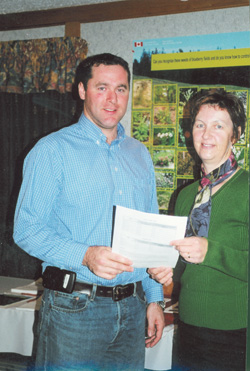
Features
Production
Research
Fitting P.E.I. blueberries into the food value chain
April 1, 2008 By Kathy Birt
Being in the business of farming
means building trust throughout the value chain, believes Ronda
Bellefontaine, a farm income improvement coordinator with the P.E.I.
Federation of Agriculture.
 |
| Reg Trainor, operations manager for Wyman’s blueberry plant in Morell, P.E.I, and Ronda Bellefontaine, farm income improvement committee coordinator with the P.E.I. Federation of Agriculture, look over some of the information. |
Being in the business of farming means building trust throughout the value chain, believes Ronda Bellefontaine, a farm income improvement coordinator with the P.E.I. Federation of Agriculture.
With the food industry becoming more and more competitive as large, nontraditional grocery retailers, such as Wal-Mart and Zellers, plus drug stores and service stations, tackle grocery sales, Bellefontaine believes this competition has a domino effect back to the commodities. Blueberry growers need to start looking at a variety of new and innovative ways to package and sell their product, she said.
“The supply chain is all the people in business who have a hand in getting a product to the consumer efficiently and effectively,” she added. The objective of each player within the value chain is to add value to the product for others in that chain, and ultimately, the end consumer.
Bellefontaine suggests that farmers and/or blueberry growers need to look at adding value to the product. “What value are you going to add?” she asked. “Are there any new product ideas?”
Wyman’s blueberry plant in Morell, P.E.I., grows and manages 1,000 acres of blueberries, providing a steady market for most Island growers. All products coming into the plant are quick frozen and sold to industrial manufacturers to be used in other products.
Reg Trainor, operations manager of the plant, says 95 per cent of the blueberries going through the plant go to these industrial manufacturers. “Our (frozen) blueberries are put into other products, such as muffins, pies, yogurt and jams,” he noted.
He believes what Wyman’s is doing is not, in fact, value added, and adds that P.E.I. blueberry growers shouldn’t even be thinking along the value added line. “Unless they (growers) want to spend thousands of dollars building a processing plant, they shouldn’t even be thinking value added,” he said.
Trainor says there are some small jam operations buying product from growers, as well, some growers who sell their product to the local wine industry, “But that’s only a small amount,” he said adding, “We used to use our cull berries to make juice concentrate, but we are not doing that any longer.”
Bellefontaine contends that working to the same end through consumer demand may be essential for blueberry growers to continue selling their crop successfully. She says there is no set formula for the value chain development. “Collaborating to compete individually can achieve certain things, but together we can achieve more.”
She believes someone needs to take the lead in the value chain partnership, adding that growers may say “it’s us,” and the processors may say “it’s us,” or the supermarkets may seem to be the leaders. “But they all need to come together,” she explained. “Someone needs to take the lead.”
Speaking in terms of supply and demand, Bellefontaine says if it’s not a supply issue, growers need to know if the consumer is happy with the price.
Print this page